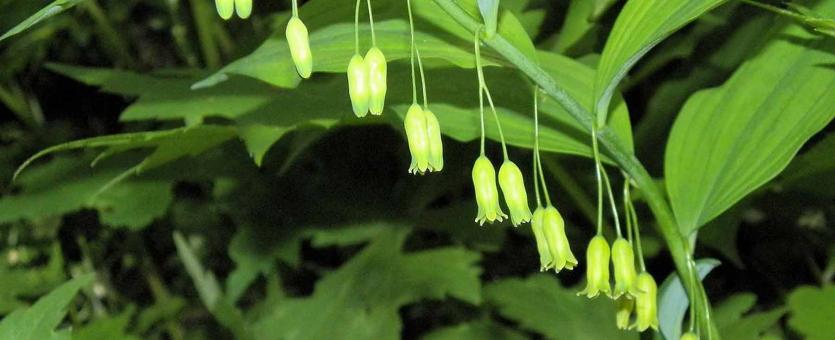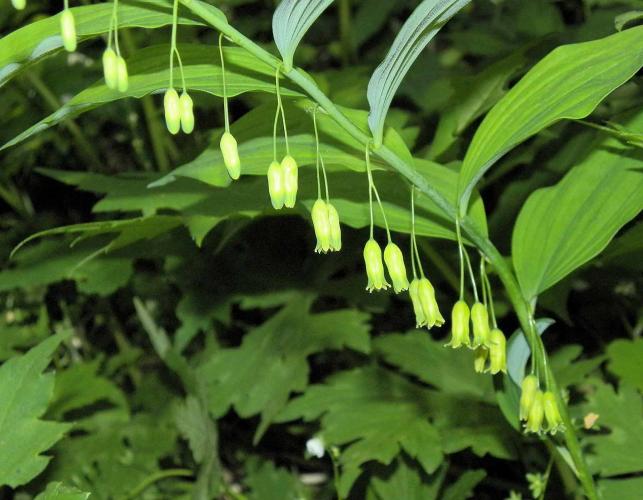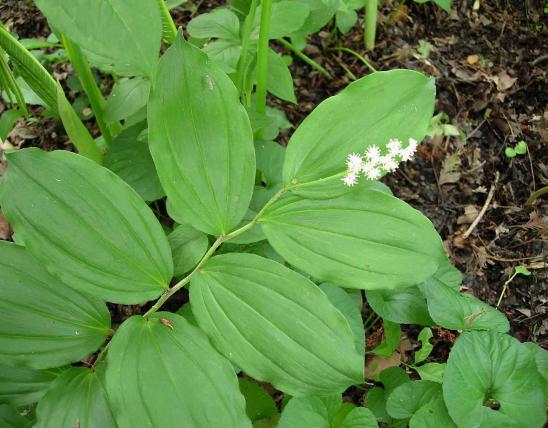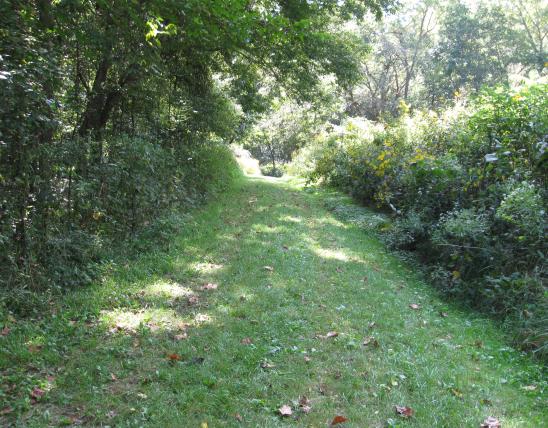
Solomon's seal is an herbaceous perennial growing from rhizomes that have with many circular scars from the stalks of former years. The stems are arching, with a series of 10–25 alternate, oval or elliptical leaves. The flowers dangle from short floral stalks (peduncles) growing out of the leaf axils. Each peduncle has 1–3 small, tubular, greenish-white flowers about ¾ inch long, which hang like bells. Blooms May–June. The leaves are sessile (stalkless), broadly elliptical, to 6 inches long, with prominent parallel veins on the undersurface. The fruit is a dark blue to black, many-seeded berry.
Similar species: Although the foliage is quite similar, the flower arrangement of the false Solomon’s seal (Maianthemum racemosum) is so different that identification presents no problem: the flowers of that species form a plumelike cluster of tiny, creamy-white florets arising from the tips of the plant stalks. Also, the fruits of false Solomon's seal are red at maturity, not dark blue.
Stem length: to nearly 5 feet, but usually about 3 feet.

Statewide.
Habitat and Conservation
Occurs in rich or rocky bottomland and upland forests in valleys and ravines; also along streambanks, roadsides, and railroads. It is also common to find Solomon's seal and related species in garden centers and in landscape plantings.
Status
Using new technology, botanists are using molecular (DNA) characteristics to provide new insights into the relationships among plant groups, and recently they've been dividing several large plant families into new, smaller, separate families. False Solomon's seal, in the newer classification system, is now placed in the Asparagaceae, the asparagus family. The the asparagus family represents a division of plants that are all former members of the Liliaceae (lily family).
Human Connections
Solomon's seal is an excellent choice for woodland, wildflower, and partial-shade gardens.
The plant is named “Solomon’s seal” because the scars on the rhizomes supposedly look like the marks of an old-fashioned wax seal made by a ring, and several legends about the biblical King Solomon revolved around the magical properties of his seal.
Although most believe the name came from the seal-like scars on the roots, it could have come from the many, many, historic medicinal uses of the plant, for many of the King Solomon legends involve miracles of healing.
Historically, Native Americans boiled and ate the rhizomes of Solomon's seal like potatoes or dried and ground them to use as a flour. Wild edibles enthusiasts point out that you can cook the young shoots of this plant and eat them more or less as you would prepare asparagus. Reports of its flavor vary. Since collecting rootstocks or young shoots may kill the plant, only harvest this native wildflower where it very abundant, and do not overcollect in any given area.
Ecosystem Connections
Many types of bees, and hummingbirds too, are drawn to the flowers' nectar.
Mammals, including deer, eat the foliage.
Insects that eat the foliage or flowers or suck the sap include certain aphids, thrips, moth caterpillars, and sawfly larvae.
Several songbirds eat the berries, including robin, bluebirds, veery, and other thrushes.

























